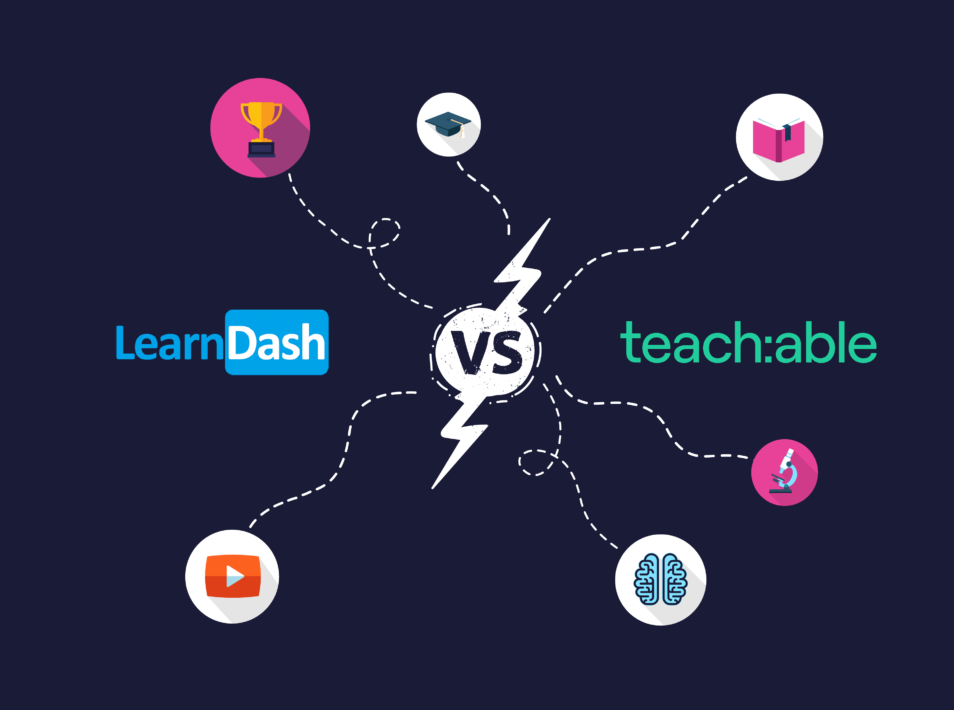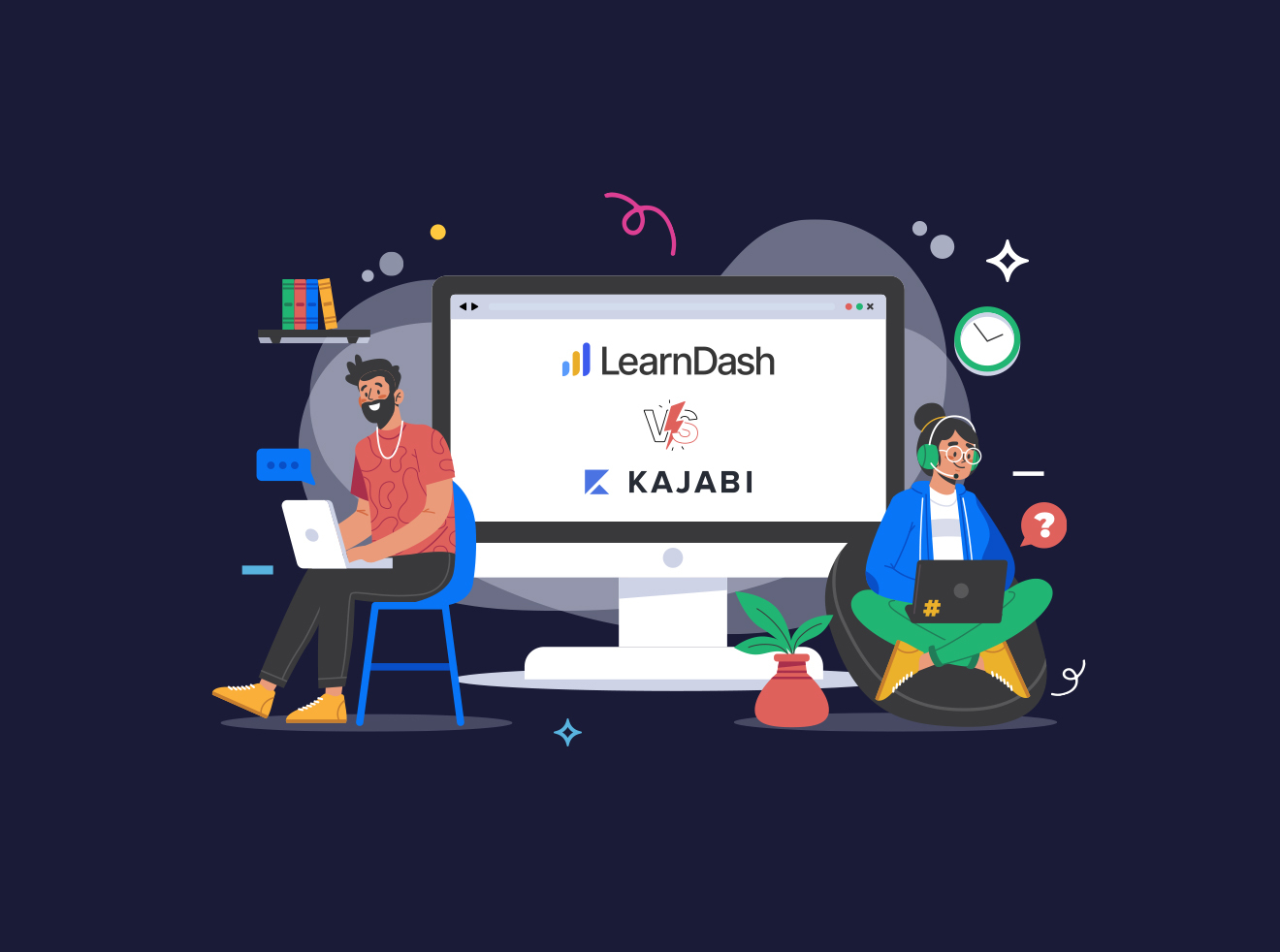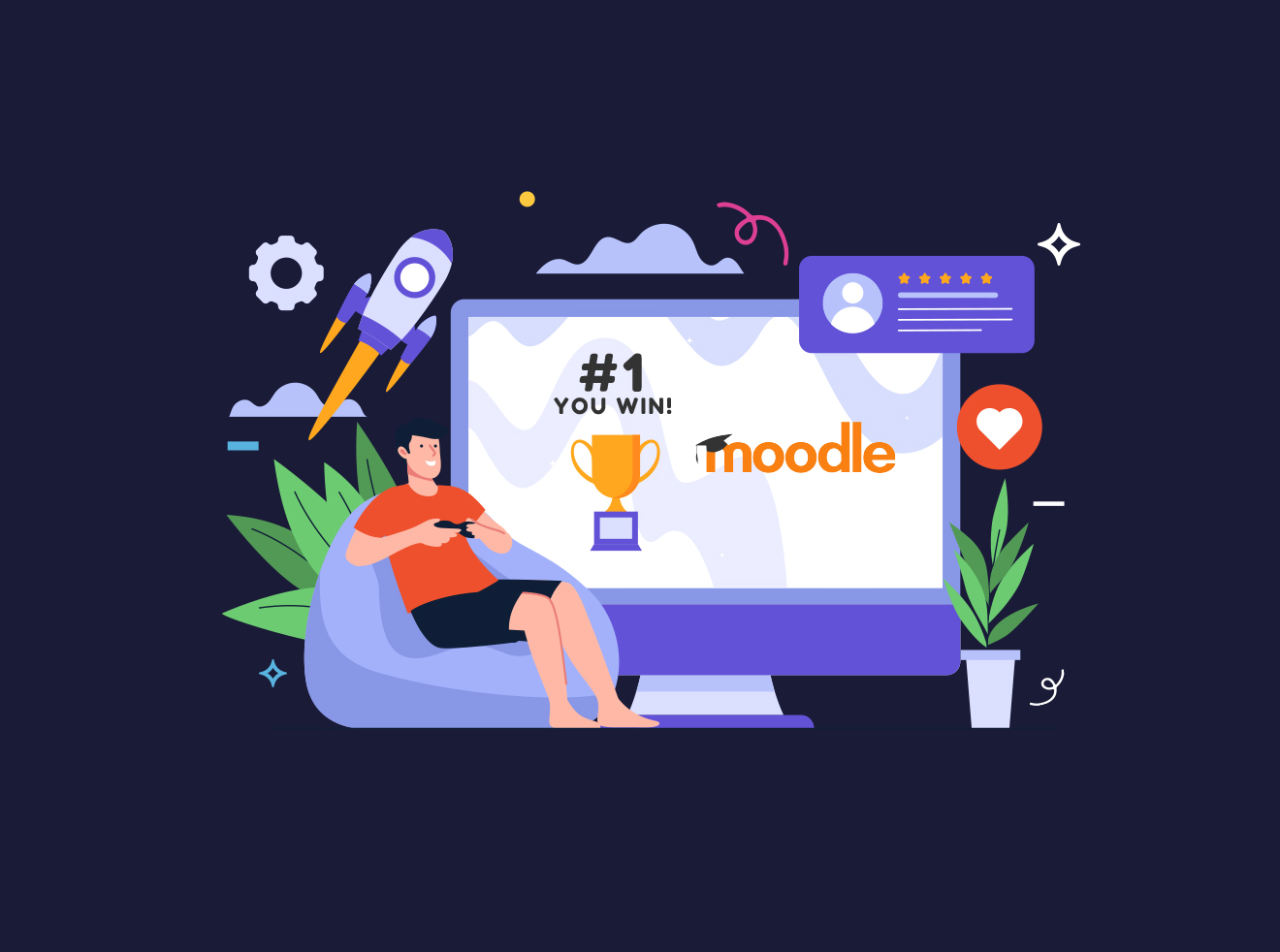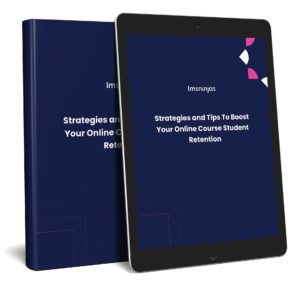Did you know the e-learning market is forecast to exceed 375 billion dollars by 2026? Now is definitely a good time to think about sharing your expertise online. Yet, there’s more to think about than timing. Choosing the right LMS for your course, audience and goals also play a role in your success.
In this post, we’ll look at two popular e-learning solutions, LearnDash vs Teachable, to help you determine which is best suited for your business.
Overview: LearnDash vs Teachable
The biggest difference when looking at LearnDash vs Teachable is that LearnDash LMS runs on WordPress. As a WordPress plugin, LearnDash runs on a self-hosted website. Meanwhile Teachable is an e-learning platform that hosts online courses for you.
Self-hosted sites offer many benefits such as unlimited freedom in features, content, and design. A LearnDash site also has zero fees for selling your courses. But, a self-hosted site also comes with its own set of challenges. Course creators have to be confident in taking on the responsibilities of working with WordPress. Difficulties include finding web and video hosting as well as handling the security and maintenance of the site.
Platforms like Teachable, that host an online school for you, come with a lower learning curve. They are generally easy to set up. This allows you to launch your site in a shorter amount of time.
Everything you need to know: LearnDash
Design
Since LearnDash LMS runs on WordPress, you have unlimited design options. You can take your pick from a huge selection of themes. The Astra, Buddyboss, and Divi themes are popular options. For a unique site, you also have the option to invest in a custom design or code it on your own.
Pricing
To get LearnDash LMS, you’ll need to buy an annual license for the plugin. Currently, you can purchase a single site license for $199, with options available for 10 and 25 sites.
Unlike Teachable, which has feature upgrades on more expensive plans, there is only one LearnDash version. If needed, the plugin’s features and functions can be enhanced through add-ons. Multiple site license packages include the Pro Panel add-on, but the platform and features remain the same.
Course creators looking for specific features can easily find them with free and paid LearnDash add-ons and additional WordPress plugins.
Selling and Marketing Your Courses
LearnDash has built-in PayPal support so you can process payments directly. A LearnDash Stripe integration is also available. If preferred, you can also use LearnDash with major shopping carts such as WooCommerce and Easy Digital Downloads. As a result, you can offer your courses in an online store and use many pricing models.
Besides allowing you to sell course access, LearnDash is compatible with membership plugins. This enables you to sell different memberships and control access to your online courses.
This LMS grants different access options for your students. If preferred, you can make your course open, so that any user, even if unregistered, can access the content. Other access options include free (with registration), one-time fees, recurring payments or manual enrollment.

Unlike Teachable, LearnDash charges no transaction fees on your sales, so you don’t miss out on portions of your revenue.
E-learning Features
LearnDash enables you to create well-structured courses made up of topics, lessons, and quizzes. Then these elements are organized into different course sections. Lessons and topics can include video clips, text, and audio files. You can also add assignments that your students can submit right on the site.
The plugin provides you with the necessary tools to create quizzes, backed with several question types. You can determine the passing grade, the number of times a user can retry the quiz, and set a limit for the time users can spend on it.
You can also award quiz certificates to users who get a certain score or above on evaluations. Students can also be awarded Course Certificates that serve as evidence of course completion.
Additionally, LearnDash comes with a drag-and-drop course builder that allows you to structure your course. From the builder, you can add lessons, topics, and quizzes. You can organize content into sections and arrange them in any order. LearnDash also allows you to reuse content across many courses.

You can control students’ progression through a course or courses by setting prerequisites. Prerequisites have to be completed for the user to access any given course, lesson, topic, or quiz. For example, you can require students to complete your Spanish Level 1 course to start your Spanish Level 2 course.
LearnDash includes social learning features such as “Groups”. You can add selected users to a group and assign them a Group Leader. Leaders are responsible for tracking their students’ progress. Additionally, each user in your LearnDash site has an individual profile page that showcases their course data.
LearnDash is also easy to “gamify” with different add-ons or gamification plugins like BadgeOS. On the other hand, Teachable offers no gamification features.
If needed, you can also use add-ons and integrations to add countless e-learning features to your site. You can further enhance your site with custom-developed solutions.
Everything you need to know: Teachable
Design
Teachable allows you to customize several aspects of your site to match your branding. You are able to select the site theme’s color and font, as well as add your own background, thumbnail, logo, and favicon. Then, you can determine which navigation links are displayed. Other customizable design elements are the colors of the navigation bar and footer area.

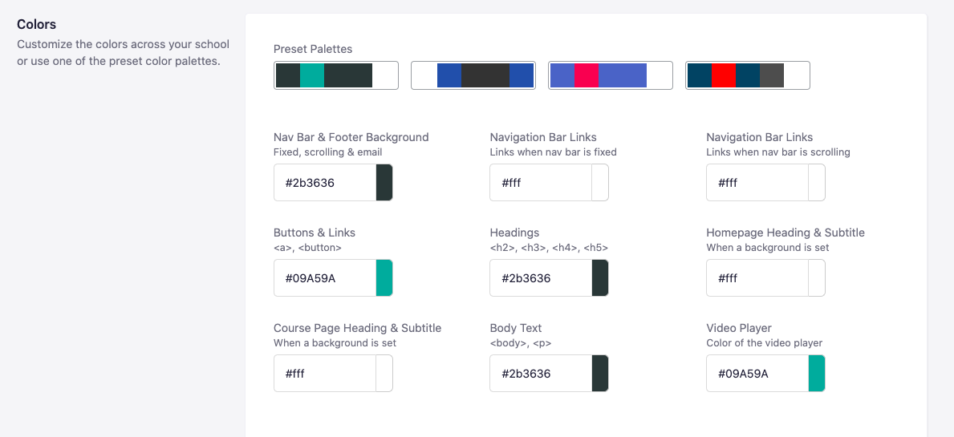
While this provides course creators a certain level of control over the look of their e-learning site, design options are very limited. In comparison, using LearnDash + WordPress gives you access to endless themes and customized design.
Pricing
For those interested in the platform, you can test out Teachable for free with limited features. Yet, with a free account you won’t be able to set up a custom domain or set up content drips.
Teachable offers different pricing plans that are billed on a monthly basis. All plans allow you to have an unlimited amount of courses and users on your site. They also include unlimited video storage and hosting, basic quizzes, and integrated payment processing.
The most affordable plan is the Basic plan for 39 USD a month and gives you access to core e-learning features. With this plan you get a custom domain, course and coaching products, as well as integrated email marketing. Limitations include teachable branding on your site, no graded quizzes and no advanced reports. All these features become available with the Pro plan for 119 USD a month.
With the Basic plan, you are also charged 5% transaction fees. Meanwhile the Pro and Business plans come with the benefit of no transaction fees.
Benefits included in the Business plan, priced at 299 USD per month, include advanced theme customization, group coaching calls, bulk student enrollment, and custom user roles.
Selling and Marketing Your Course
Teachable offers four different options to sell your courses:
- Free: With Teachable you can create courses that students can access for free. All students have to do is sign up for an account on your site.
- One-time payment: With this pricing option, your users purchase course access by paying the total price in a single payment.
- Subscription: When you price a course as a subscription, students will only be able to access a course as long as they continue to pay their subscription fee. Subscriptions can have a variety of payment schedules including weekly, monthly or yearly.
- Payment plan: On a payment plan, the total cost of the course is broken down into monthly payment installments. Upon paying all installments, students have indefinite access to the course.
Teachable offers “Teachable payments” for schools operating in the United States, Canada, UK and Germany. With this payment gateway, credit card purchases are processed by Stripe and paid directly to you. Teachable also enables your students to use PayPal as a payment gateway to purchase courses. Payouts are then made to your account on a determined schedule.
Keep in mind that Teachable charges you a transaction fee for each of these operations. With LearnDash LMS, there are no fees so you get 100% of your sale earnings.
In terms of marketing resources, Teachable allows you to set up users as affiliates. This way users help you promote your courses and receive a commission on the sales completed with their affiliate code.
Teachable also allows you to create different sales pages for your courses using premade templates. These templates are ideal for beginners, since they provide you with an easy to edit layout.
E-learning Features
Teachable provides a “school” where you can host all the courses you wish to create. Your school’s set-up includes a home page, course catalogue page and a privacy policy page. Furthermore, you can create additional custom pages to enhance your site as you see fit.
Within your school, you can create an unlimited amount of courses and host an unlimited number of students. Courses contain lectures that can be grouped into different sections. Lectures can contain all types of content such as video, audio, text, images, files, and quizzes. Lecture quizzes can be non-graded or graded, but the latter is only available with the Professional plan and up.
Starting with the Teachable Basic plan, you’ll be able to set up a schedule to drip in course content. With a content drip, users will only be able to progressively access lessons in the order you have scheduled them.
Teachable allows you to add other functions to your courses through integrations. Yet, the options available are very limited, especially when compared to the endless possibilities available for LearnDash. The available integrations include: Zoom, MailChimp, CovertKit, Sumo, Segment and Google Analytics.
Each course has its checkout page, thank you page and up to 10 sales pages.
Teachable enables you to have several admin-level users. This allows you to add collaborators or other instructors to your site. However, the number of admin-level users is limited according to the plan you have purchased. The Basic Plan, for example, is limited to only 2 admin-level users.
The Bottom Line: LearnDash vs Teachable
| Feature | LearnDash | Teachable |
| Design | Unlimited design options. Can use any WordPress theme. Custom WordPress design. | Limited options to customize: font, color, thumbnail, favicon, and logo. |
| Pricing | Annual single site license $199. Options available for 10 and 25 site licenses. | Basic plan $39 a month (only core features, 5% transaction fees, and Teachable branding on your site). Pro plan $119 a month. Business plan $299 a month. |
| Scalability | No limitations | Very limited. If your business grows or changes, you are limited to the features offered by the platform. Can’t customize, pick and choose features or develop unique solutions for your site. |
| Integrations | Premium and free add-ons available for the majority of third-party products. If not, can be custom developed. | Teachable integrations: Zoom, MailChimp, ConvertKit, Zapier*, Webhooks, Vizia. |
| E-commerce | Built-in PayPal support Integrates with Stripe and e-commerce plugins like WooCommerce and EDD. Supports free and paid courses (buy now or recurring payments). Integrations allow you to sell memberships, subscriptions, and course bundles. No transaction fees on your sales. Sales landing pages available with extra plugins. Affiliate programs available with extra plugins. | Four different course selling options: free, one-time payment, subscription, payment installments “Teachable payments” gateway for the United States, Canada, UK, and Germany (processed by Stripe). Transaction fees for operations Affiliates Sale pages with templates |
| E-learning | Courses made up of topics, lessons, assignments, and quizzes. Quiz and course certificates. Drag and drop course builder. Prerequisites. Third-party add-ons that offer hundreds of features. | Each site is a “school” that hosts all the courses. Courses are made of lectures that can be grouped into sections Graded quizzes are only available for professional/business plans. Drip content option. The Number of admin/instructor accounts is restricted based on the plan. |
| Time to set-up | More time-intensive, there is a big learning curve for total WP beginners. | Easy to learn, can launch a site quickly. |
Finally, the best LMS for you is the one that best accommodates your needs. Beginners looking to launch a course quickly, without diving into WordPress, will likely find Teachable more appealing. However, this platform can come at a steep price, especially if you get a higher-level plan.
Those comfortable with WordPress can benefit from LearnDash’s robust e-learning functionalities. LearnDash also provides affordability and flexibility in terms of features and web design.
If you are looking to set up an e-learning website but don’t know where to start, reach out to our LMS Ninjas! We can help you choose the best LMS for your course, set up your website, and customize features according to your needs.
